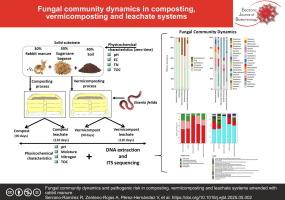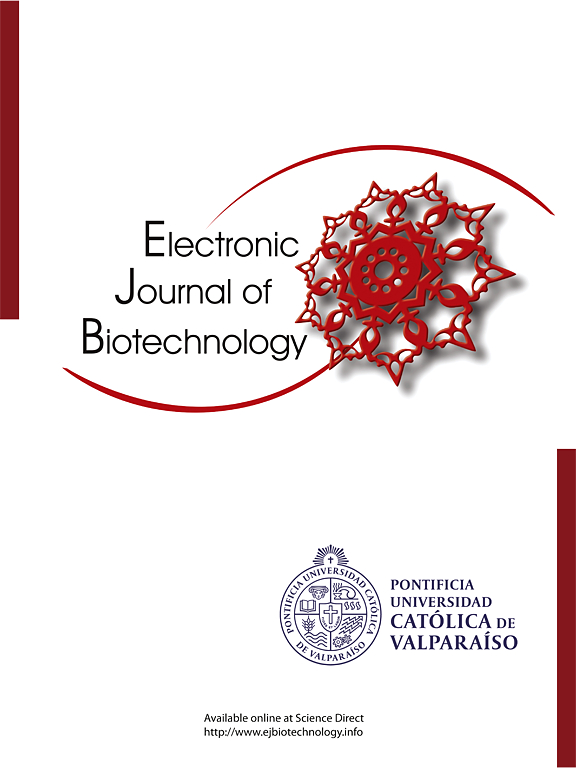兔粪改良堆肥、蚯蚓堆肥和渗滤液系统中真菌群落动态及致病风险
IF 2.5
4区 生物学
Q3 BIOTECHNOLOGY & APPLIED MICROBIOLOGY
引用次数: 0
摘要
了解堆肥和蚯蚓堆肥系统中真菌群落的动态对于优化废物管理实践和最大限度地降低病原体风险至关重要。因此,本研究利用Illumina公司的MiSeq平台进行内部转录间隔序列(ITS)测序和FUNGuild分析,评估了堆肥、蠕虫堆肥和兔粪处理渗滤液系统中真菌群落结构和潜在致病风险。结果各处理均以担子菌属为主,而病原菌属微曲霉在堆肥和蚯蚓堆肥处理后分别减少到5%和7%,渗滤液中分别减少到1%和13%。考虑到微曲霉与人类皮肤病的关联,在有机废物用于农业用途之前,对其进行适当处理至关重要。相比之下,FUNGuild的分析显示,大量的腐养真菌,如曲霉、Preussia、Botryotrichum和Acremonium,都能产生促进养分循环和土壤肥力的酶。结论蚯蚓堆肥具有降低病原菌风险、促进真菌驱动的养分循环的潜力,为可持续农业和有机废物管理提供了实践见解。引用方式:Serrano-Ramírez RdP, Zenteno-Rojas A, Pérez-Hernández V等。兔粪改良堆肥、蚯蚓堆肥和渗滤液系统中真菌群落动态及致病风险。中国生物医学工程学报(英文版);2009;77。https://doi.org/10.1016/j.ejbt.2025.05.002。本文章由计算机程序翻译,如有差异,请以英文原文为准。

Fungal community dynamics and pathogenic risk in composting, vermicomposting and leachate systems amended with rabbit manure
Background
Understanding the dynamics of fungal communities in composting and vermicomposting systems is essential for optimizing waste management practices and minimizing pathogen risks. For this reason, this study assessed the fungal community structure and potential pathogenic risks in composting, vermicomposting and leachate systems amended with rabbit manure, using Illumina’s MiSeq platform for internal transcribed spacer (ITS) sequencing and FUNGuild analysis.
Results
Phylotypes from Basidiomycota were predominant in all treatments, while the pathogenic genus Microascus, initially abundant (37%), showed a significant reduction to 5% and 7% following composting and vermicomposting, respectively, and to 1% and 13% in their leachates. Given Microascus’s association with human skin diseases, proper handling of organic waste is critical before its agricultural use. In contrast, the FUNGuild analysis revealed a high abundance of saprotrophic fungi such as Aspergillus, Preussia, Botryotrichum, and Acremonium known for producing enzymes that promote nutrient cycling and soil fertility.
Conclusions
These findings highlight the potential for vermicomposting to reduce pathogen risks while enhancing fungal-driven nutrient recycling, offering practical insights for sustainable agriculture and organic waste management.
How to cite: Serrano-Ramírez RdP, Zenteno-Rojas A, Pérez-Hernández V, et al. Fungal community dynamics and pathogenic risk in composting, vermicomposting and leachate systems amended with rabbit manure. Electron J Biotechnol 2025;77. https://doi.org/10.1016/j.ejbt.2025.05.002.
求助全文
通过发布文献求助,成功后即可免费获取论文全文。
去求助
来源期刊

Electronic Journal of Biotechnology
工程技术-生物工程与应用微生物
CiteScore
5.60
自引率
0.00%
发文量
50
审稿时长
2 months
期刊介绍:
Electronic Journal of Biotechnology is an international scientific electronic journal, which publishes papers from all areas related to Biotechnology. It covers from molecular biology and the chemistry of biological processes to aquatic and earth environmental aspects, computational applications, policy and ethical issues directly related to Biotechnology.
The journal provides an effective way to publish research and review articles and short communications, video material, animation sequences and 3D are also accepted to support and enhance articles. The articles will be examined by a scientific committee and anonymous evaluators and published every two months in HTML and PDF formats (January 15th , March 15th, May 15th, July 15th, September 15th, November 15th).
The following areas are covered in the Journal:
• Animal Biotechnology
• Biofilms
• Bioinformatics
• Biomedicine
• Biopolicies of International Cooperation
• Biosafety
• Biotechnology Industry
• Biotechnology of Human Disorders
• Chemical Engineering
• Environmental Biotechnology
• Food Biotechnology
• Marine Biotechnology
• Microbial Biotechnology
• Molecular Biology and Genetics
•Nanobiotechnology
• Omics
• Plant Biotechnology
• Process Biotechnology
• Process Chemistry and Technology
• Tissue Engineering
 求助内容:
求助内容: 应助结果提醒方式:
应助结果提醒方式:


